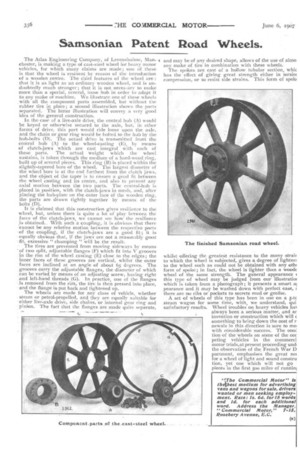Samsonian Patent Road Wheels.
Page 20

If you've noticed an error in this article please click here to report it so we can fix it.
The Atlas Engineering Company, of Levenshulme, Manchester, is making a type of cast-steel wheel for heavy motor vehicles, for which many claims are made; one of these is that the wheel is resilient by reason of the introduction of a wooden centre. The chief features of the wheel are : that it is as light as an ordinary wooden wheel, and is undoubtedly much stronger ; that it is not neces.:ary to make more than a special, central, loose hub in order to adapt it to any make of machine. We illustrate one of these wheels . with all the component parts assembled, but without tile rubber tire in place; a second illustration shows the parts separated. The latter illustration will convey a very good idea of the general construction.
In the case of a live-axle drive, the central hub (A) would be keyed or otherwise secured to the axle, but, in other forms of drive, this part would ride loose upon the axle, and the chain or gear ring would be bolted to the hub by the hub-bolts (D). The actual drive is transmitted from the central hub (A) to the wheel-casting (E), by means of clutch-jaws which are cast integral with each of these parts. The actual weight which the wheel sustains, is taken through the medium of a hard-wood ring, built up of several pieces. This ring (B) is placed within the slightly-tapered bore of the wheel. The largest diameter of the wheel bore is at the end furthest from the clutch jaws, and the object of the taper is to ensure a good fit between the wheel casting and its centre, and also to prevent amaxial motion between the two parts. The central-hub is placed in position, with the clutch-jaws in mesh, and, after placing the hub-plate on the outer face of the wooden ring, the parts are drawn tightly together by means of the bolts (D).
It is claimed that this construction gives resilience to the wheel, but, unless there is quite a lot of play between the faces of. the clutch-jaws, we cannot see how the resilience ..is obtained.. With such .a coupling, it is obvious that there cannot be any relative motion between the respective parts , of the conpling, if the clutch-jaws are a good fit; it is .• equally obvious that, if the jaws are not a reasonably good ,-fit; excessive " thumping " will be the result.
The tires are prevented from moving sideways by means of two split, adjustable flanges (F) which fit into V grooves . in the rim of the wheel. casting (E) close to the edges; the inner faces of these grooves are vertical, whilst the outer faces are inclined at an angle of about 65 degrees. The _grooves carry the adjustable flanges, the diameter of which can be varied by means of an adjusting screw, having right .and left-hand threads (G). In practice, one of the flanges is removed from the rim, the tire is then pressed into place, and the flange is put back and tightened up. . The wheels are made for any class of vehicle, whether
• steam or petrOl-propelled, and they are equally suitable for either live-axle drive, side chains, or internal gear ring and .Pinion. The fact that the flanges are made quite separate, -4 and may be of any desired shape, allows of the use of atm any make of tire in combination with these wheels. The spokes are cast of a hollow tubular section, whic has the effect of giving great strength either in torsiot compression, or to resist side strains. This form of spok
whilst offering the greatest resistance to the many strait to which the wheel is subjected, gives a degree of lightne: to the wheel such as could not be obtained with any otho form of spoke; in fact, the wheel is lighter than a woo& wheel of the same strength. The general appearance • this type of wheel may be judged from our illustratiol which is taken from a photograph; it presents a smart aj pearance and it may be washed down with perfect ease, there are no ribs or pockets to secrete mud or grese.
A set of wheels of this type has been in use on a 5-tc steam wagon for some time, with, we understand, qui satisfactory results. Wheel troubles on heavy vehicles hal always been a serious matter, and ar invention or construction which will something to bring down the cost of r newals in this direction is sure to me with cOnsiderable success. The conc Lion -of the wheels on some of the cot peting vehicles in the commerci motor trials,at present proceeding Lind the observation of the French War D partment, emphasises the great net for a wheel of light and sound oonstru tion, yet one which will not go pieces in the first 5oo miles of runnin






















